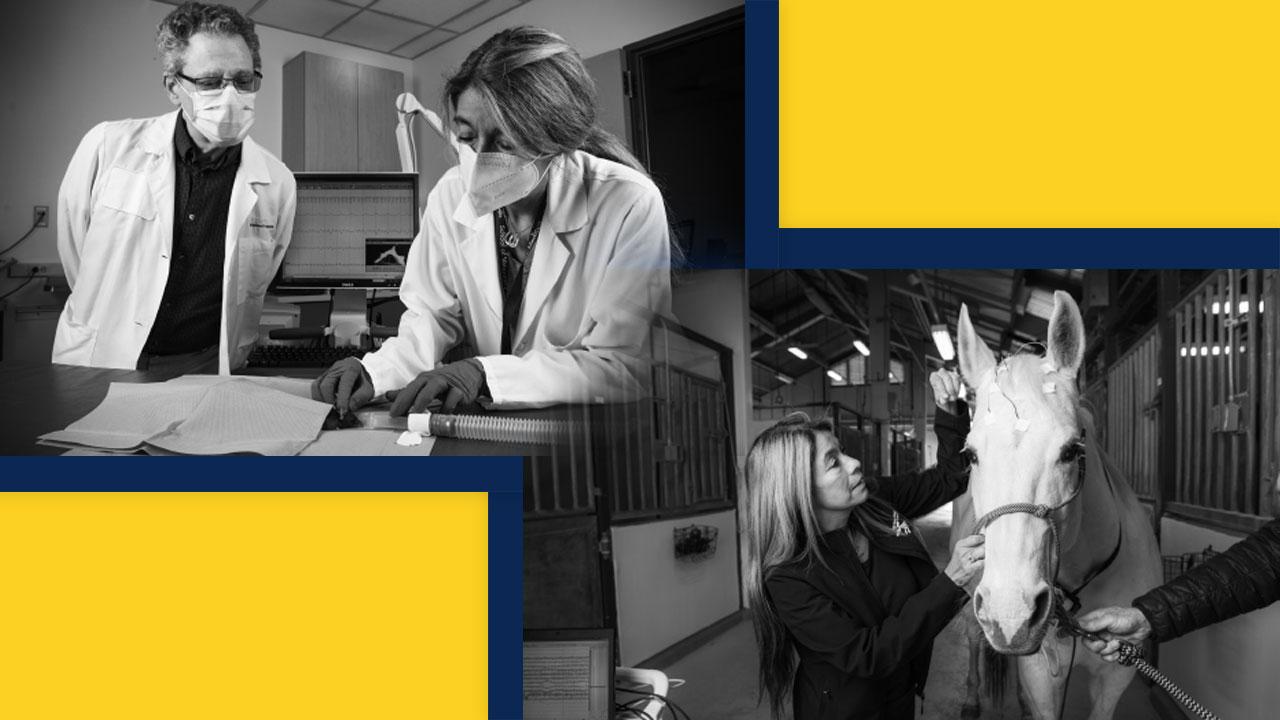
Research Impacts
From Lab to Clinic
As a leader in veterinary clinical medicine as well as basic science research, UC Davis offers unique collaborative opportunities that bring innovation from the lab bench to the clinic.
Nearly 20 years ago when Professor Monica Aleman was a graduate student working on her PhD, she was assisting in research on healthy horses under general anesthesia. To her surprise, one of the horses under anesthesia had some odd reactions. First, she noticed his ears pulled completely back and within a few minutes of administering halothane (a commonly used anesthesia), the horse exhibited sweating, a rapid heart rate, high body temperature and muscle rigidity – all signs of a malignant hyperthermic episode. Despite the clinicians’ best efforts to cool the horse and reverse the anesthesia, it died on the table.
Up to that point, malignant hyperthermia (MH) had not been documented in horses. Despite the clinical evidence, Aleman was told, “MH doesn’t happen in horses.” Undeterred, she began collecting equine tissue samples and sought the advice of Dr. Isaac Pessah, a renowned researcher in ryanodine receptors that are important in activating muscle and nerve cells.
Certainly, the pandemic has been a hindrance on these collaborations between clinical scientists and basic researchers, but Pessah sees the value in fostering more of these interactions.
Pessah explained that MH is a severe reaction that occurs in an individual who has a genetic mutation for the condition. It typically happens in response to particular medications used during anesthesia when there is an uncontrolled rise of calcium in the cell, which activates biochemical processes related to muscle activation. In most cases, the syndrome is caused by a defect in the ryanodine receptor.
The condition, first described in a medical journal in 1960, affects one in 5,000 to 50,000 cases where people are given anesthetic gases. Most people who are susceptible are generally otherwise unaffected when not exposed, and may be unaware of their predisposition to the condition. The risk of death with proper treatment is about 5%, while without intervention is around 75%.
Aleman persisted in the genetic testing to prove that an MH mutation occurs in horses. Pessah assisted in fine-tuning the research by helping her discover the physiological mechanisms behind MH, specifically in the horse, by replicating studies he had conducted previously in mice. They published their results in Muscle & Nerve in 2004.
Thanks to that basic research, Aleman and others were able to develop a screening test for the genetic mutation in horses. If they have the mutation, other anesthesia can be used during surgery which will not trigger an MH episode and endanger the horse’s life.
Basic Research Discoveries Relevant to Human and Animal Health
Aleman and Pessah lost touch for several years after their initial collaboration as they worked in different areas of the UC Davis campus. When Pessah’s office was moved to the Health Sciences District, he was in the café grabbing a cup of coffee when he ran into Aleman. They chatted about current cases and research.
Pessah was working on a mouse study looking at the effects of caffeine on the ryanodine receptor when exposed to halothane. His initial results seemed to indicate that caffeine synergizes the toxicity of halothane or related general anesthetic in mice with the human mutation for MH. But he couldn’t explain how. They weren’t experiencing classic dramatic MH responses, like in horses or humans, but the mice were still dying under anesthesia. He had shelved the project for 14 months, unsure of the next steps.
“Monica pulled me back in kicking and screaming about the size of the study and how we could put it together in a different way,” said Pessah, who also serves as associate dean of research for the school. “The study would probably still be sitting on my computer if not for her persistence.”
Aleman wheeled a cart over to Pessah’s lab with various instruments to record further clinical info, like an EEG to measure brain waves and respiration, to find more clues.
“We started finding in the mice that their brain waves were going flat, as well as going into respiratory and cardiac arrest,” said Aleman, who was appointed as the Dr. Terry Holliday Equine and Comparative Neurology Presidential Chair in 2019. “That was something completely new.”
By preventing the classical contraction of the muscle in MH susceptible mice, Aleman and Pessah discovered another mechanism that triggered MH – caffeine. Their recent collaboration was published in Molecular Pharmacology in 2020.
“This study was the perfect opportunity to discover another way – if you have the mutation – that you are going to have central and peripheral effects that could also end up killing you,” Pessah said.
The clinical relevance to this basic research applies more to humans than horses. Because there are too many mutations in humans that can make one susceptible to MH, it isn’t practical to screen for them before surgery. But if caffeine is linked to synergizing the reaction that leads to MH when under anesthesia, doctors could recommend that patients scheduled for surgical procedures should avoid caffeine, Pessah said.
Certainly, the pandemic has been a hindrance on these collaborations between clinical scientists and basic researchers, but Pessah sees the value in fostering more of these interactions.
“And when a clinician calls you with a really interesting case, don’t ignore it!” he said.
